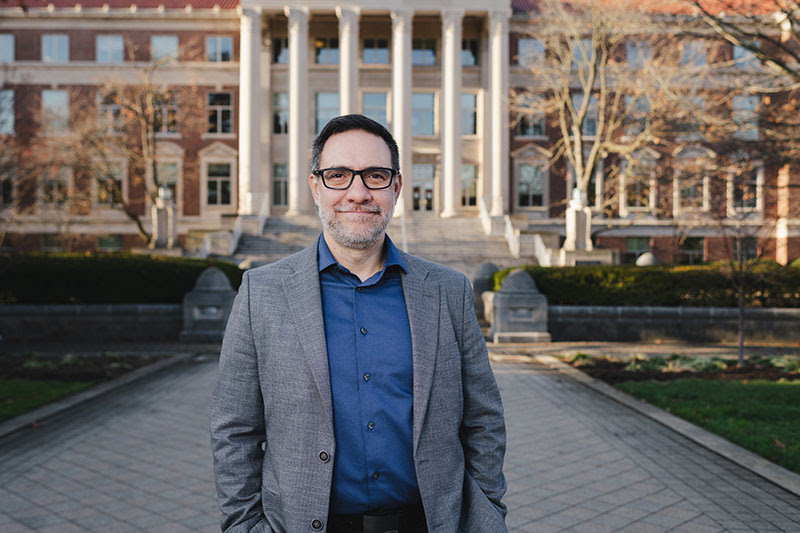
WEST LAFAYETTE — For urban and rural communities, the “digital divide” is more than just the lack of access to high-speed internet — it’s a disconnect from economic and social ties and opportunities in a fast-changing society.
Roberto Gallardo, Purdue University’s vice president for engagement, has spent the past decade analyzing local and regional community economic development, including the use of technology. He notes that the U.S. government’s plans to invest $42.5 billion in the Broadband Equity, Access and Deployment (BEAD) program will help narrow this divide by ensuring a growing number of Americans can connect to fast internet, regardless of their location or socioeconomic status.

“The federal program recognizes that in today’s interconnected world, high-speed internet access is not a luxury; it’s a necessity,” said Gallardo, who was named in October 2023 to lead the newly formed Purdue Broadband Team. “It is an essential component to workforce training and regional development, helping rural communities to thrive.”
Gallardo, who also serves as director of the Purdue Center for Regional Development, has garnered the attention of top federal officials for his regional economic development expertise. In January, the Federal Reserve Board announced that Gallardo was selected to join its Community Advisory Council for a three-year term. The Federal Reserve plays a crucial role in managing the U.S. economy and financial system, aiming to promote stability, growth, and prosperity.
“As a member of the CAC, I’ll be able to provide ground-level perspective, advice and recommendations to the Fed on relevant policy matters and emerging issues, such as broadband and rural economic development,” said Gallardo, who serves in a similar capacity for the regional Federal Reserve Bank in Chicago.
In 2016, Gallardo developed the Digital Divide Index, a dataset that provides a reliable way to measure the gap between the haves and have-nots of digital access and use. Gallardo said the tool is intended to serve policymakers as a pragmatic resource.
The index scores include both broadband availability/adoption and socioeconomic characteristics.
Gallardo said the Digital Divide Index has been requested more than 150 times since 2020 by government entities, nonprofits, and higher education institutions to help with planning and research.
Gallardo said the digital barrier goes beyond the lack of infrastructure. It also means communities, especially rural areas, are disconnected from economic and social ties and opportunities in the 21st century.
“Those constraints can limit any community’s ability to overcome economic struggles. The disconnect is an underpinning to persistent poverty,” Gallardo said. “As a leading research university and land-grant institution, Purdue is well positioned to find more effective and equitable solutions for the ever-increasing digital society and economy.”
Research bandwidth
During Gallardo’s tenure, the Purdue Center for Regional Development has taken on multiple economic development projects for state and federal governments. Three current projects have a combined value of more than $3 billion in potential maximum grants awarded. The PCRD’s job is to document the impact of these programs and tell stories about these government grant programs.
READI 1.0
One such program is the state of Indiana’s Regional Economic Acceleration and Development Initiative.
The PCRD and the Indiana University Public Policy Institute are collaborating on a four-year project to examine the economic and community impact of the first round of the $500 million READI grant program.
NSF Engines
At the federal level, the PCRD was awarded a one-year contract from the National Science Foundation to establish the framework and process to evaluate the impact of the NSF Regional Innovation Engines competition. The NSF Engines grant program is intended to stimulate innovation-driven economic growth in selected U.S. regions, with special attention to underperforming or disadvantaged regions. The 10 recipients have the potential to receive up to $160 million over the next decade.
Build Back Better
In addition to the NSF Engines project, the PCRD is part of a team evaluating the impact of the Biden administration’s $1 billion Build Back Better Regional Challenge, which aims to boost economic recovery from the pandemic and rebuild American communities, including those grappling with decades of disinvestment. The program is administered through the Economic Development Administration, an agency in the U.S. Department of Commerce.
Broadband’s role in a pandemic-changed world
Gallardo said after the COVID-19 pandemic struck, online activities — from e-learning to remote working — became crucial. Without adequate and reliable connectivity, Americans quickly learned the value and necessity of high-speed, reliable internet.
But even before the global health crisis, Gallardo said there was a digital divide and a lack of understanding of the value and necessity of broadband.
“There was a disconnect, a lack of awareness. But when COVID hit, it changed everything. It literally accelerated ten years’ worth of awareness work, at the minimum,” Gallardo said.
The Purdue Broadband Team is part of Purdue President Mung Chiang’s “ABCD” plan to better serve the state through four initiatives: Airport for the Greater Lafayette region, Broadband for rural counties, a Hard-Tech Corridor for central Indiana, and Purdue@DC, which brings unique capabilities to the nation’s capital.
Information: Wes Mills, wemills@purdue.edu
Source: Roberto Gallardo







.png)















